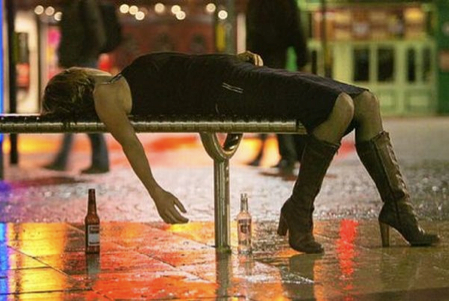Alcohol. Labelling
First smokes. Now booze?

Binge drinking, from alcohol available at 200,000 outlets in the UK, is now much more common. Public health professionals say that this is a crisis.

Our news team reports. Should alcoholic drink bottles and cans carry graphic health warnings like the one above? Health professional organisations in the UK now say yes. They say that containers of wine and spirits should carry warnings that are practically as explicit as those that by law must be carried on cigarette packets. An example is shown above.
Since the 1950s the amount of pure alcohol drunk per head in the UK has more than doubled, from around 5 to 11 litres a year. Recent figures do not include a possible extra 2 litres from cross-channel purchases. In this time consumption of alcohol as contained in beer has increased modestly, in wine has increased by a factor of 12, and as contained in spirits has trebled (1).
In the UK, currently somewhat over half of all containers of alcoholic drinks carry advice on 'sensible drinking' as a voluntary arrangement agreed between government officials and the alcohol industry. This specifies a maximum of 21 'units' a week for men and 14 'units' a week for women, together with a warning against drinking alcohol when pregnant.
The UK Faculty of Public Health says this is not good enough. Faculty representative Mark Bellis from the National Health Service centre in Liverpool says: 'At the moment when people think about the dangers associated with alcohol they are more likely to think of a city centre disturbance rather than breast cancer….Health warnings would help educate the public and give them key information before they decide to buy a can or bottle of alcohol' He continued: 'People don't realise that drink increases your risk of injury, a stroke, heart disease, liver disease and many forms of cancer, and don't realise its potential long-term implications for them'.
Graphic warnings would need to be obligatory, specified by law, Mark Bellis suggests that warnings could say 'Alcohol increases risks of violence and abuse' and 'Alcohol increases risks of mouth, throat and other cancers', and that it raises the risk of breast cancer, is involved in a quarter of all deaths of young men aged 16-24, and reduces sexual function in men and fertility in men and women. That's plenty for a graphic designer to engage with – and see the example above. He points out that warnings would 'help to redress the balance between the need for this information and the bombardment of positive images of alcohol manufacturers we get from their association with big sporting and cultural events like the Olympics'.
Binge drinking – drinking to get drunk – is now much more common in the UK. Apart from the risk of disease, including stroke, this is a cause of mayhem in city centres, violence, and unwanted pregnancy including in underage girls.
No need for warnings, says alcohol trade
The alcohol trade sees no need for warnings. Henry Ashworth of the Portman Group, the trade organisation with which the UK government discusses policy, says: 'Given that 78 per cent of people drink within the chief medical officer's guidelines, it wouldn't be proportionate to have these more graphic warnings. There's no comparison between alcohol and tobacco. The advice with tobacco is don't smoke, but with alcohol it's not to exceed three or four units a day'.
How big a public health issue is alcohol in the UK? Estimates of annual deaths from diseases that are directly caused by alcohol is just under 10,000 a year. If deaths to which alcohol contributes, such as a substantial proportion of homicide, suicide, car crashes, arson and other violent events is included, the number is estimated at anything up to 40,000 a year. This is far less than the estimated 114,000 UK deaths a year caused by smoking and other use of and exposure to tobacco. It is far more than the 700 and 200 annual deaths attributed to respectively to heroin and cocaine. Other significant figures, are as follows. In the UK now, around 200,000 locations are licensed to sell alcoholic drinks, something like 1.8 million jobs are in whole or in part alcohol-dependent, and the alcohol industry is worth £29 billion a year to the UK economy (2). Explicit graphic warnings on alcoholic drink containers? Don't hold your breathalyser.
References
- Institute of Alcohol Studies. Alcohol Consumption in the UK. St Ives, Cambridge: IAS, 2010.
- HM Government. The Government's Alcohol Strategy. London: Home Department, March 2012.






